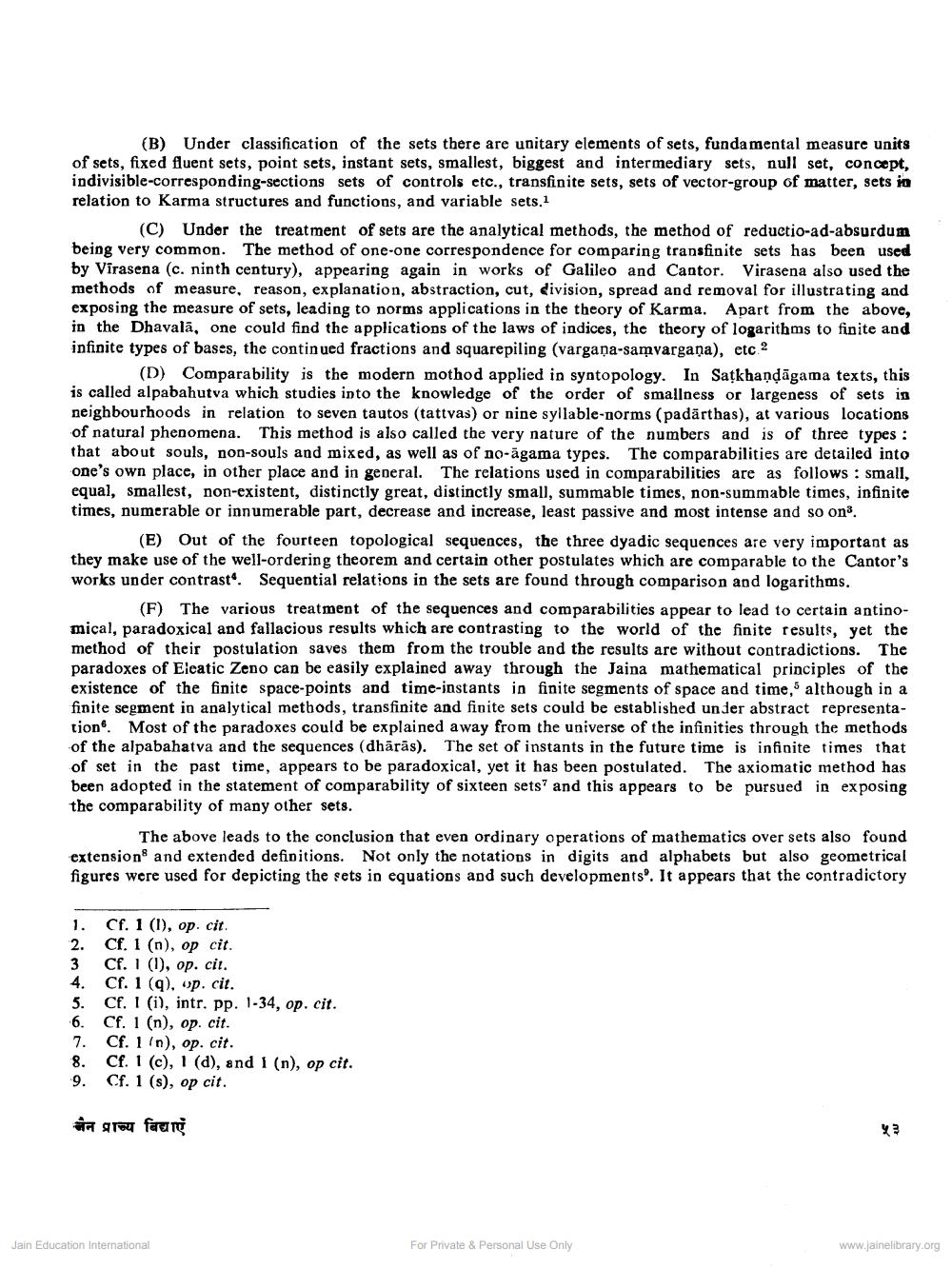Book Title: Jaina Ulterior Motive of Mathematical Philosophy Author(s): L C Jain, C K Jain Publisher: Z_Deshbhushanji_Maharaj_Abhinandan_Granth_012045.pdf View full book textPage 5
________________ (B) Under classification of the sets there are unitary elements of sets, fundamental measure units of sets, fixed fluent sets, point sets, instant sets, smallest, biggest and intermediary sets, null set, concept, indivisible-corresponding-sections sets of controls etc., transfinite sets, sets of vector-group of matter, sets in relation to Karma structures and functions, and variable sets. 1 (C) Under the treatment of sets are the analytical methods, the method of reductio-ad-absurdum being very common. The method of one-one correspondence for comparing transfinite sets has been used by Virasena (c. ninth century), appearing again in works of Galileo and Cantor. Virasena also used the methods of measure, reason, explanation, abstraction, cut, division, spread and removal for illustrating and exposing the measure of sets, leading to norms applications in the theory of Karma. Apart from the above, in the Dhavala, one could find the applications of the laws of indices, the theory of logarithms to finite and infinite types of bases, the continued fractions and squarepiling (vargana-samvargana), etc.? (D) Comparability is the modern mothod applied in syntopology. In Satkhandāgama texts, this is called alpabahutva which studies into the knowledge of the order of smallness or largeness of sets is neighbourhoods in relation to seven tautos (tattvas) or nine syllable-norms (padārthas), at various locations of natural phenomena. This method is also called the very nature of the numbers and is of three types : that about souls, non-souls and mixed, as well as of no-agama types. The comparabilities are detailed into one's own place, in other place and in general. The relations used in comparabilities are as follows: small, equal, smallest, non-existent, distinctly great, distinctly small, summable times, non-summable times, infinite times, numerable or innumerable part, decrease and increase, least passive and most intense and so on. (E) Out of the fourteen topological sequences, the three dyadic sequences are very important as they make use of the well-ordering theorem and certain other postulates which are comparable to the Cantor's works under contrasto. Sequential relations in the sets are found through comparison and logarithms. (F) The various treatment of the sequences and comparabilities appear to lead to certain antinomical, paradoxical and fallacious results which are contrasting to the world of the finite results, yet the method of their postulation saves them from the trouble and the results are without contradictions. The paradoxes of Eleatic Zeno can be easily explained away through the Jaina mathematical principles of the existence of the finite space-points and time-instants in finite segments of space and time, although in a finite segment in analytical methods, transfinite and finite sets could be established under abstract representation. Most of the paradoxes could be explained away from the universe of the infinities through the methods of the alpabahatva and the sequences (dhārās). The set of instants in the future time is infinite times that of set in the past time, appears to be paradoxical, yet it has been postulated. The axiomatic method has been adopted in the statement of comparability of sixteen sets and this appears to be pursued in exposing the comparability of many other sets. The above leads to the conclusion that even ordinary operations of mathematics over sets also found extension and extended definitions. Not only the notations in digits and alphabets but also geometrical figures were used for depicting the sets in equations and such developments'. It appears that the contradictory 1. 2. 3 4. Cf. 1 (1), op. cit. Cf. 1 (n), op cit. cf. I (1), op. cit. Cf. 1 (q), op. cit. Cf. 1 (i), intr. pp. 1-34, op. cit. Cf. 1 (n), op. cit. Cf. 1 in), op. cit. Cf. 1 (c), 1 (d), and 1 (n), op cit. Cf. 1 (s), op cit. 7. 8. 9. जैन प्राच्य विद्याएं Jain Education International For Private & Personal Use Only www.jainelibrary.orgPage Navigation
1 ... 3 4 5 6 7 8 9 10 11
